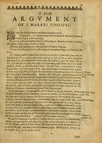St. Mark’s Ghospel may be well divided into four parts.
The first part, of the preparation that was made to the manifestation of Christ: chap. 1. in the beginning.
The second, of his manifesting himself by Preaching and Miracles, and that in Galilee: the residue of the 1. chap. unto the 10. chap.
The third, of his coming into Jewry, towards his Passion: chap. 10.
The fourth, of the Holy week of his Passion in Jerusalem: chap. 11. to the end of the book.
Of St. Mark and his conversation with the two Apostles St. Paul and St. Barnabee, we have at large Act. 12 and 15, somewhat also Col. 4 and 2 Tim. 4, and to Philemon. Moreover of his familiarity with the Prince of the Apostles St. Peter, we have 1 Pet. 5. For so it pleased our Lord, that only two of the Evangelists should be of his twelve Apostles, to wit, St. Matthew and St. John. The other two, St. Mark and St. Luke, he gave unto us of the Disciples of his two most principal and most glorious Apostles St. Peter and St. Paul. Whose Ghospels therefore were of Antiquity counted as the Ghospels of St. Peter and St. Paul themselves. Mark the Disciple, and interpreter of Peter (saith St. Jerom) according to that which he heard of Peter’s mouth, wrote at Rome a brief Ghospel at the request of the Brethren (about 10 or 12 years after our Lord’s Ascension) which when Peter had heard, he approved it, and with his authority did publish it to the Church to be read, as Clemens Alexandrinus writeth lib. 6 Hypotypos.
In the same place St. Jerom addeth, how he went into Aegypt to preach, and was the first Bishop of the chief city there, named Alexandria: and how Philo Judaeus at the same time seeing and admiring the life and conversation of the Christians there under St. Mark, who were Monks, wrote a book thereof, which is extant to this day. And not only St. Jerom (in Marco, and in Philone) but also Eusebius Hist. lib. 2 ca. 15–17, Epiphanius Secta 29 Nazaraeorum lib. 1 to 2, Cassianus de Instit. Caenobiorum lib. 2 ch. 5, Sozomenus lib. 1 ch. 12, Nicephorus lib. 2 ch. 15, and diverse others do make mention of the said Monks out of the same Author. Finally, He died (saith St. Jerom) the 8 year of Nero, and was buried at Alexandria, Anianus succeeding in his place. But from Alexandria he was * translated to Venice, Anno Dom. 830.
It is also to be noted, that in respect of St. Peter, who sent St. Mark his scholar to Alexandria, and made him the first Bishop there, this See was esteemed next in dignity to the See of Rome, and the Bishop thereof was accounted the chief Metropolitan or Patriarch of the East, and that by the first Council of Nyce. Whereof see St. Leo ep. 53, St. Gregory lib. 5 ep. 60 and lib. 6 ep. 37.
Margin Notes
- In Catal. Script. Ecclesiast.
- Philo de Supplicibus.
- In Catalogo.
- * Naucler. generat. 28.

